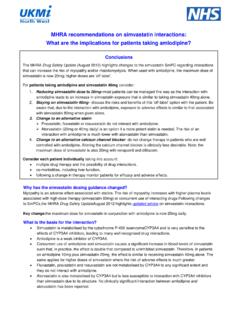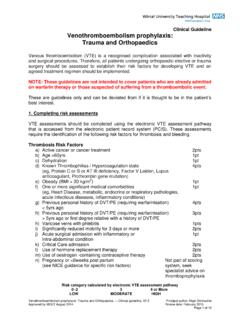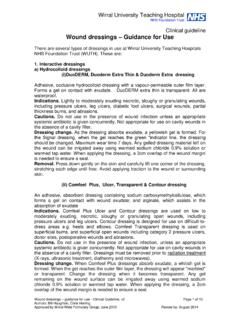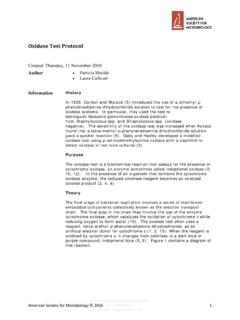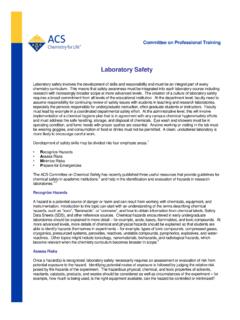Transcription of Low Molecular Weight Heparin Prescribing and ...
1 Clinical guideline Low Molecular Weight Heparin Prescribing and Administration (Adults). The National Patient Safety Agency issued guidance on ways of reducing dosing errors when Prescribing low Molecular Weight heparins (LMWH) in July 2010. The main issues highlighted include1: Lack of consideration of patients' accurate Weight before dosing The dose of LMWH may still be miscalculated based on the known Weight LMWH doses and frequencies are sometimes used outside guideline recommendations for the required clinical indication or other predisposing factors such as renal failure.
2 Limited information is communicated during transfer of care indication, dosage, intended duration of treatment and the patient's Weight . This guideline is to provide information to support the safe and appropriate use of LMWHs across both secondary and primary care. Choice of LMWH. The choice of low Molecular Weight Heparin used at Wirral University Teaching Hospital (WUTH). depends on the indication of treatment and the patient's renal function. Indication Renal function Choice of LMWH. Venous Thromboembolism (VTE) Irrespective of renal function Tinzaparin prophylaxis*.
3 Treatment of VTE CrCl 20ml/min Tinzaparin CrCl <20ml/min) Enoxaparin Acute coronary syndrome (ACS) alone CrCl 20ml/min **Fondaparinux ( no other indications requiring full anticoagulation) CrCl <20ml/min Enoxaparin ACS plus other indications requiring full Irrespective of renal function Enoxaparin anticoagulation ( mechanical prosthetic valves, treatment of VTE or atrial fibrillation requiring high level anticoagulation). *except orthopaedics directorate orthopaedics VTE prophylaxis guidelines are being updated at the time of writing this joint LMWH guideline **Fondaparinux is a synthetic pentasaccharide that inhibits factor Xa.
4 CrCl = Creatinine Clearance Low Molecular Weight Heparin Prescribing and administration for adults clinical guideline, v1a Principle author: Michelle Wong Update approved by Wirral Drug and Therapeutics Committee: May 2011 Review by: Jan 2014. Page 1 of 10. Dosing considerations Renal function A patient's renal function should be considered before Prescribing a LMWH as this may affect the choice and the dose of LMWH. However, this should not delay initiation of treatment but every effort must be made to calculate subsequent dose based on this information.
5 Renal function should be checked before starting treatment and then at appropriate intervals if continuing on LMWH ( routinely every 3 months or sooner if the patient's condition changes in a way that might affect renal function). A patient's estimated creatinine clearance can be calculated using Cockcroft and Gault's equation. Cockcroft and Gault equation for creatinine clearance Creatinine clearance (mL/min) = Y x (140-age) x Weight Serum creatinine umol/L. Where Y = for males and for females For obese patients, adjusted body Weight should be used Adjusted body Weight = ideal body Weight + x (actual body Weight ideal body Weight ).
6 Ideal body Weight (IBW) should be used to calculate the creatinine clearance unless patients are underweight. IBW can be calculated using the following equation: IBW Females = [ + ( x every inch over 5ft)] kg IBW Males = [50kg + ( x every inch over 5ft)] kg For underweight patients use actual body Weight . An online creatinine clearance calculator is available at: : Renal function may be reported as estimated Glomerular Filtration Rate (eGFR) (in mL/ ) which is not equivalent to the estimates of creatinine clearance described above (reported in mL/min).
7 Since eGFR estimates have not yet been validated for drug dosing, dose adjustment for renal impairment continues to be based on estimates of creatinine clearance ( calculated from the Cockcroft and Gault equation or from a 24-hour urine collection). Weight Treatment doses of LMWHs are calculated based on the patient's Weight . Therefore, where possible, an accurate Weight (in kg) should be obtained using validated weighing equipment by personnel trained in using the weighing equipment. In exceptional circumstances, when a patient cannot be weighed, body Weight information can be obtained from the patient or carer.
8 However, if this information cannot be obtained, as a last resort, the Weight may be estimated by the prescriber. The patient's Weight should be documented in the clinical notes (medical or nursing notes or GP. clinical system) AND the hospital Prescribing system (when in use) or the community patient medication administration chart (PMAC) at the start of the treatment. The patient's Weight should be added to the FP10 prescription. This is required by the community pharmacist when assessing the dose. It should then be rechecked at appropriate intervals, at least every 3 months or sooner if the patient's clinical condition changes in a way that might affect their body Weight .
9 Every effort should be made to ensure an accurate Weight (in kg) is obtained prior to a LMWH being prescribed but this should not delay treatment. If it is not possible to weigh the patient, or an estimated Weight is used to calculate the dose of LMWH, this should be made clear in the patient's clinical notes and re-assessed at a later date if appropriate. Low Molecular Weight Heparin Prescribing and administration for adults clinical guideline, v1a Principle author: Michelle Wong Update approved by Wirral Drug and Therapeutics Committee: May 2011 Review by: Jan 2014.
10 Page 2 of 10. Prevention of venous thromboembolism Duration LMWH should continue to be administered for as long as the patient remains at risk of venous thromboembolism (VTE). Calculating the right dose ALL patients who are admitted to hospital MUST have their risk of developing a venous thromboembolism (VTE) assessed on admission, reassessed within 24 hours of admission and whenever the clinical situation changes2. PCIS will provide guidance on the choice of LMWH and dose depending on the patient's renal function (and patient's Weight if their CrCl <20ml/min).

